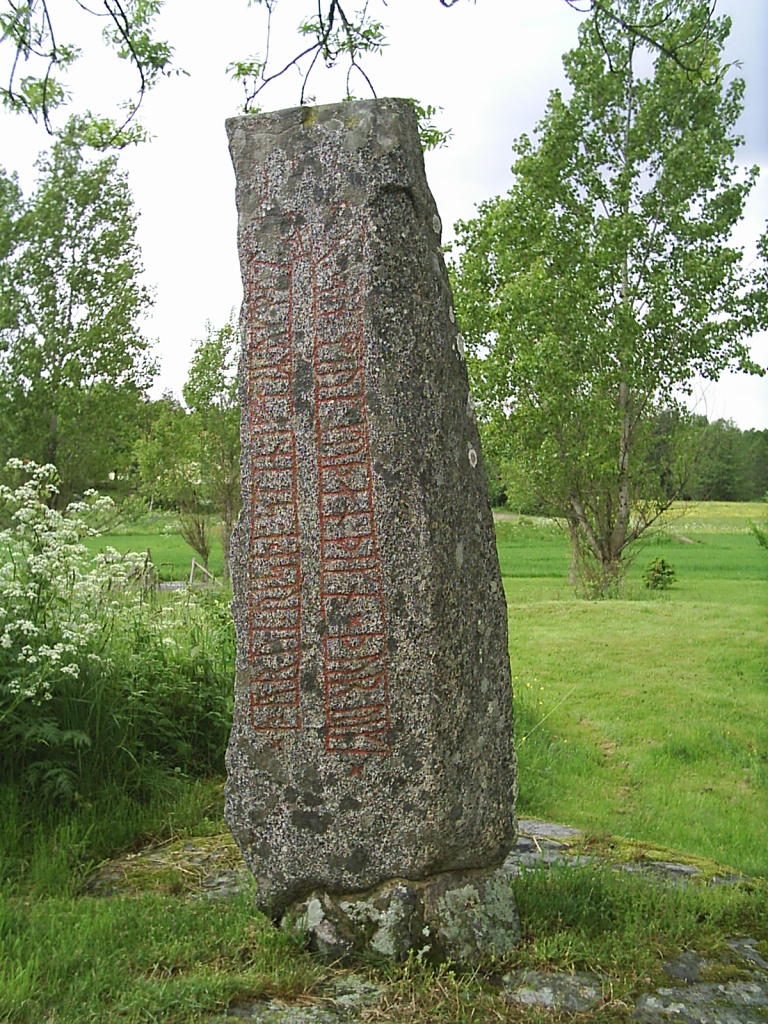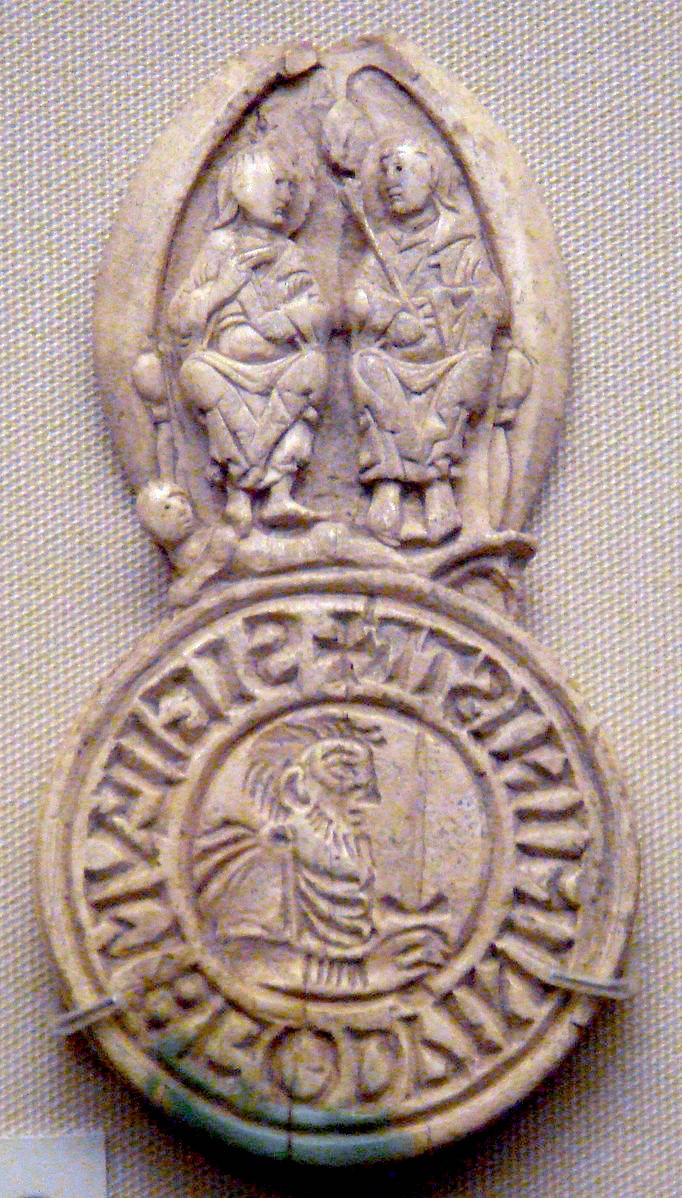|
Rydsgård Runestone
The Rydsgård Runestone, designated as DR 277 under Rundata, is located in the woods just outside the park at Rydsgård manor, which is near Skurup, Skåne, Sweden. Description The Rydsgård Runestone is classified as being carved in runestone style RAK. Similar to the Velanda Runestone, the inscription describes the deceased as being a good '' þegn'', or thegn. The exact role of thegns in southern Sweden is a matter of debate, but the most common view is that these persons constituted a Nordic elite somehow connected to Danish power. It is thought that thegn-stones point to areas where they came from. From such power centres they could be sent forth to rule border areas in so-called ''tegnebyar''.Löfving, Carl (2001). ''Gothia som Dansk/Engelskt Skattland: Ett Exempel på Heterarki Omkring år 1000'' (doctoral dissertation). Göteborg. Inscription Transliteration into Latin characters :× kata × karþi × kuml × þausi × iftiʀ × suin × baluks ¶ sun × bunta × sin × ... [...More Info...] [...Related Items...] OR: [Wikipedia] [Google] [Baidu] |
Skurup
Skurup is a locality and the seat of Skurup Municipality, Skåne County, Sweden Sweden, formally the Kingdom of Sweden,The United Nations Group of Experts on Geographical Names states that the country's formal name is the Kingdom of SwedenUNGEGN World Geographical Names, Sweden./ref> is a Nordic country located on ... with 7,565 inhabitants in 2010. References Populated places in Skurup Municipality Populated places in Skåne County Municipal seats of Skåne County Swedish municipal seats {{Skåne-geo-stub ... [...More Info...] [...Related Items...] OR: [Wikipedia] [Google] [Baidu] |
Skåne
Scania, also known by its native name of Skåne (, ), is the southernmost of the historical provinces (''landskap'') of Sweden. Located in the south tip of the geographical region of Götaland, the province is roughly conterminous with Skåne County, created in 1997. Like the other former provinces of Sweden, Scania still features in colloquial speech and in cultural references, and can therefore not be regarded as an archaic concept. Within Scania there are 33 municipalities that are autonomous within the Skåne Regional Council. Scania's largest city, Malmö, is the third-largest city in Sweden, as well as the fifth-largest in Scandinavia. To the north, Scania borders the former provinces of Halland and Småland, to the northeast Blekinge, to the east and south the Baltic Sea, and to the west Öresund. Since 2000, a road and railway bridge, the Öresund Bridge, bridges the Sound and connects Scania with Denmark. Scania forms part of the transnational Øresund Region. From n ... [...More Info...] [...Related Items...] OR: [Wikipedia] [Google] [Baidu] |
Sweden
Sweden, formally the Kingdom of Sweden,The United Nations Group of Experts on Geographical Names states that the country's formal name is the Kingdom of SwedenUNGEGN World Geographical Names, Sweden./ref> is a Nordic country located on the Scandinavian Peninsula in Northern Europe. It borders Norway to the west and north, Finland to the east, and is connected to Denmark in the southwest by a bridgetunnel across the Öresund. At , Sweden is the largest Nordic country, the third-largest country in the European Union, and the fifth-largest country in Europe. The capital and largest city is Stockholm. Sweden has a total population of 10.5 million, and a low population density of , with around 87% of Swedes residing in urban areas in the central and southern half of the country. Sweden has a nature dominated by forests and a large amount of lakes, including some of the largest in Europe. Many long rivers run from the Scandes range through the landscape, primarily ... [...More Info...] [...Related Items...] OR: [Wikipedia] [Google] [Baidu] |
Old Norse Language
Old Norse, Old Nordic, or Old Scandinavian, is a stage of development of North Germanic languages, North Germanic dialects before their final divergence into separate Nordic languages. Old Norse was spoken by inhabitants of Scandinavia and their Viking expansion, overseas settlements and chronologically coincides with the Viking Age, the Christianization of Scandinavia and the consolidation of Scandinavian kingdoms from about the 7th to the 15th centuries. The Proto-Norse language developed into Old Norse by the 8th century, and Old Norse began to develop into the modern North Germanic languages in the mid-to-late 14th century, ending the language phase known as Old Norse. These dates, however, are not absolute, since written Old Norse is found well into the 15th century. Old Norse was divided into three dialects: Old West Norse, ''Old West Norse'' or ''Old West Nordic'' (often referred to as ''Old Norse''), Old East Norse, ''Old East Norse'' or ''Old East Nordic'', and ''Ol ... [...More Info...] [...Related Items...] OR: [Wikipedia] [Google] [Baidu] |
Rundata
The Scandinavian Runic-text Data Base ( sv, Samnordisk runtextdatabas) is a project involving the creation and maintenance of a database of runic inscriptions. The project's goal is to comprehensively catalog runestones in a machine-readable way for future research. The database is freely available via the Internet with a client program, called Rundata, for Microsoft Windows. For other operating systems, text files are provided or a web browser can be used to interact with the web applicatioRunor History The origin of the Rundata project was a 1986 database of Swedish inscriptions at Uppsala University for use in the Scandinavian Languages Department. At a seminar in 1990 it was proposed to expand the database to cover all Nordic runic inscriptions, but funding for the project was not available until a grant was received in 1992 from the ''Axel och Margaret Ax:son Johnsons'' foundation. The project officially started on January 1, 1993 at Uppsala University. After 1997, the proje ... [...More Info...] [...Related Items...] OR: [Wikipedia] [Google] [Baidu] |
Runestone Style
:''The term "runestone style" in the singular may refer to the Urnes style.'' The style or design of runestones varied during the Viking Age. The early runestones were simple in design, but towards the end of the runestone era they became increasingly complex and made by travelling runemasters such as Öpir and Visäte. A categorization of the styles was developed by Anne-Sophie Gräslund in the 1990s. Her systematization is considered to have been a break-through and is today a standard. The styles are RAK, Fp, Pr1, Pr2, Pr3, Pr4 and Pr5, and they cover the period 980-1130, which was the period during which most runestones were made. The styles Pr1 and Pr2 correspond to the Ringerike style, whereas Pr3, Pr4 and Pr5 belong to what is more widely known as the Urnes style.Sawyer 2000:32 Below follows a brief presentation of the various styles by showing sample runestones according to Rundata's annotation. RAK RAK is the oldest style and covers the period 980-1015 AD, but the Ru ... [...More Info...] [...Related Items...] OR: [Wikipedia] [Google] [Baidu] |
Style RAK
:''The term "runestone style" in the singular may refer to the Urnes style.'' The style or design of runestones varied during the Viking Age. The early runestones were simple in design, but towards the end of the runestone era they became increasingly complex and made by travelling runemasters such as Öpir and Visäte. A categorization of the styles was developed by Anne-Sophie Gräslund in the 1990s. Her systematization is considered to have been a break-through and is today a standard. The styles are RAK, Fp, Pr1, Pr2, Pr3, Pr4 and Pr5, and they cover the period 980-1130, which was the period during which most runestones were made. The styles Pr1 and Pr2 correspond to the Ringerike style, whereas Pr3, Pr4 and Pr5 belong to what is more widely known as the Urnes style.Sawyer 2000:32 Below follows a brief presentation of the various styles by showing sample runestones according to Rundata's annotation. RAK RAK is the oldest style and covers the period 980-1015 AD, but the Ru ... [...More Info...] [...Related Items...] OR: [Wikipedia] [Google] [Baidu] |
Velanda Runestone
The Velanda Runestone ( sv, Velandastenen), designated as Vg 150 in the Rundata catalog, is a runestone dated to the late tenth century or the early eleventh century that is located in the village of Velanda, Trollhättan Municipality, Västra Götaland County, Sweden, which is in the historic province of Västergötland. It was discovered around 1910 by a farmer named Jacobsson. Description The Velanda Runestone is inscribed in Old Norse with the Younger Futhark. Above the arch of the runic text band is the outline of an eagle's head facing to the left. The stone was raised by a woman named Þyrvé in memory of her husband Ögmundr. The runic inscription states that he was ''miok goðan þegn'' or "a very good thegn". About fifty other runestones refer to the deceased being a thegn. Of these, four use exactly the same phrase, ''miok goðan þegn'': Vg 73 in Synnerby, Vg 108 in Tängs gamla, Vg 137 in Sörby, and DR 99 in Bjerregrav. The exact role of thegns in southern Sweden is ... [...More Info...] [...Related Items...] OR: [Wikipedia] [Google] [Baidu] |
Thegn
In Anglo-Saxon England, thegns were aristocratic landowners of the second rank, below the ealdormen who governed large areas of England. The term was also used in early medieval Scandinavia for a class of retainers. In medieval Scotland, there were local officials known as thanes. Etymology The Old English (, "man, attendant, retainer") is cognate with Old High German and Old Norse ("thane, franklin, freeman, man"). The thegn had a military significance, and its usual Latin translation was , meaning soldier, although was often used. ''An Anglo-Saxon Dictionary'' describes a thegn as "one engaged in a king's or a queen's service, whether in the household or in the country". It adds: "the word ... seems gradually to acquire a technical meaning, ... denoting a class, containing several degrees", but what remained consistent throughout was its association with military service. Origins The precursor of thegn was the ''gesith'', the companion of the king or great lord, ... [...More Info...] [...Related Items...] OR: [Wikipedia] [Google] [Baidu] |
Runestones In Scania
A runestone is typically a raised stone with a runic inscription, but the term can also be applied to inscriptions on boulders and on bedrock. The tradition began in the 4th century and lasted into the 12th century, but most of the runestones date from the late Viking Age. Most runestones are located in Scandinavia, but there are also scattered runestones in locations that were visited by Norsemen during the Viking Age. Runestones are often memorials to dead men. Runestones were usually brightly coloured when erected, though this is no longer evident as the colour has worn off. The vast majority of runestones are found in Sweden. History The tradition of raising stones that had runic inscriptions first appeared in the 4th and 5th century, in Norway and Sweden, and these early runestones were usually placed next to graves. The earliest Danish runestones appeared in the 8th and 9th centuries, and there are about 50 runestones from the Migration Period in Scandinavia. Most runeston ... [...More Info...] [...Related Items...] OR: [Wikipedia] [Google] [Baidu] |




